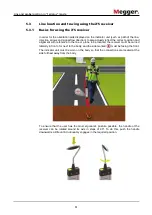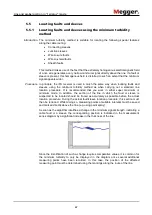
Line and probe location in “Ferrolux” mode
61
5.3.6
Line tracing
If the entire course of a line needs to be traced (e.g. for the purpose of mapping), it is
advisable to connect the transmitter directly to the line and start tracing at the
connection point. As low a signal frequency as possible is recommended for this
application. Provided that it is supported by the transmitter, a SignalSelect-coded signal
should be coupled in. This makes it much easier to identify lines that run in parallel
during tracing.
Basically, current-carrying lines that cannot be disconnected from the mains can also be
traced. To prevent mix-ups with other supply lines, a suitable transmitter should be
placed directly above the line to be traced, and a high-frequency signal (e.g. 9.8 kHz or
33 kHz) coupled in inductively.
If only part of the line needs to be traced (e.g. for terrain examination as preparation for
excavation work), the first step is to find the line in the affected area and determine its
alignment. If a direct connection to the line is not possible, inductive signal coupling
should also be carried out in this case if possible using a transmitter placed directly
above the line. The optimal positioning of the transmitter depends on the type of
transmitter that is used and its antenna arrangement.
The receiver should be operated in super maximum mode during line tracing. In this
mode, a small offset to the line that is being searched for is reflected in a considerable
level drop.
Introduction
Procedure
Summary of Contents for digiPHONE+2
Page 2: ...2 ...
















































